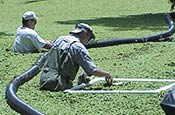Biocontrol
— Bug Used to Control Invasive Plant
Posted:
6/17/04
The unique balance
of wildlife and resources is rarely noticed. But when a dense
mat of plants covering the surface of a clear dark lake impedes
natural water flow and leads to flooding or fish kill, it
is noticeable. In the latter case, the plant mat blocks sunlight
needed for submerged plants to complete photosynthesis, and
the resulting low oxygen conditions affect the wildlife.
 Concern
about a thick green mat of fresh-water plants on the surface
of Cypress Lake near Lake Charles led to the deliberate release
there of some insects native to Brazil that like to eat the
plants. One hundred of the Florida population of salvinia
weevils (Cyrtobagous salviniae ) were released in a
one-square meter area of common salvinia (Salvinia minima)
covering a large portion of the 55 acre lake in Moss Bluff.
The adult weevils are expected to feed on the plant terminals
and the larvae, to tunnel into and feed on the rhizomes. “Eventually,
the plants will weaken, sink, and die,” according to
Seth Johnson, PhD, an entomologist with the LSU Agricultural
Center. Johnson oversaw the release of the weevils and is
monitoring their progress at 1-2 month intervals.
Concern
about a thick green mat of fresh-water plants on the surface
of Cypress Lake near Lake Charles led to the deliberate release
there of some insects native to Brazil that like to eat the
plants. One hundred of the Florida population of salvinia
weevils (Cyrtobagous salviniae ) were released in a
one-square meter area of common salvinia (Salvinia minima)
covering a large portion of the 55 acre lake in Moss Bluff.
The adult weevils are expected to feed on the plant terminals
and the larvae, to tunnel into and feed on the rhizomes. “Eventually,
the plants will weaken, sink, and die,” according to
Seth Johnson, PhD, an entomologist with the LSU Agricultural
Center. Johnson oversaw the release of the weevils and is
monitoring their progress at 1-2 month intervals.
Many states, including
Louisiana, have traditionally used herbicides to reduce the
density of such nature-disrupting plant infestations; they
are impossible to completely destroy. Such invasive plants
reproduce and grow rapidly, requiring regular reapplication
of chemicals to keep the infestation under control —
a very expensive method of maintaining nature’s balance.
Introduction of a natural predator can be less expensive if
the predator can survive and control a burgeoning invasive
plant population without causing any other disruptions. Biocontrol
also reduces expenses when the introduced control species
reproduces naturally. Johnson and Kevin Savoie, Louisiana
Sea Grant Extension Agent, are hoping this will be the case
at Cypress Lake.
This project is
one of several sponsored by the Louisiana Department of Wildlife
and Fisheries and the LSU Agricultural Center to control common
salvinia. The same weevil species was released in similar
plots at Maurepas Wildlife Management Area last May, and at
Lake Henderson, in St James Parish, Maurepas and Joyce Wildlife
Management areas in the summer of 2003.
The released insects
were grown and studied in a greenhouse at LSU for a period
before they were released as a biocontrol measure. A small
quantity of Cyrtobagous salviniae was obtained by Johnson
from Phillip Tipping of the USDA-Animal and Plant Health Inspection
Service (APHIS) in Fort Lauderdale, Florida, last year. Johnson
continues to study the weevils in the greenhouse and in the
field, and to compare the biocontrol areas to control plots
containing no weevils.
Back
to Main